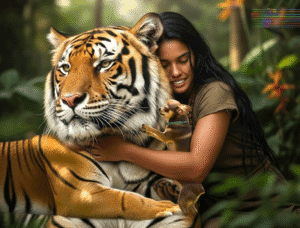AI is now able to create stunningly realistic images and videos of wildlife, however it has no real understanding of what is truly natural, safe, or ethical. Within moments it’s possible to create and share content that can fuel harmful tourism, spread myths, and normalise behaviours that, in real life, causes animal suffering, all without even realising it. This blog explores why AI-generated animal imagery has the potential to be extremely dangerous for captive wild animal welfare, and how you can help to combat this future growing trend.

AI generated images can promote unrealistic and dangerous interaction expectations.
In the past year, artificial intelligence has exploded on social media platforms, flooding sites such as Instagram and TikTok with a new breed of content. With just a few simple words typed into a prompt box, anyone can create realistic-looking images or videos without the need for a camera, editing skills or even to travel to a far reaching location. Ask AI to create a video of a tiger playing with a tiny dog, or an elephant strolling along a tropical beach, or even chimpanzees enjoying afternoon tea, and within moments it magically exists. But here lies a deeply troubling problem. AI has no understanding of what is “real” for animals, and more importantly, what is right for their welfare.
While AI can create imagery depicting captivating wildlife, it can also produce dangerously misleading content. These fakes may seem harmless at first glance, but they have the power to fuel unrealistic expectations, encourage harmful tourism practices, and distort the public’s understanding of captive wild animal welfare. To create these images, AI models learn from huge collections of existing content scraped together from across the internet. The internet is already home to a huge amount of wildlife and animal media, some of which is staged, manipulated, or captured in genuinely poor welfare conditions. The AI cannot tell the difference between a truly wild animal and one that has been dressed up, restrained, or forced into performing unnatural behaviours. It simply learns that “people like to see this” and repeats it. This not only fuels the flames but makes it possible to infinitely add to the issue of such abusive content being easily available online.
The consequences of this are subtle but powerful. Most people can spot a cartoon animal or a fantasy scene, but AI-generated wildlife imagery can easily be manipulated to look photo realistic. If someone sees a picture of a dancing bear or monkeys wearing football shirts, they might laugh and share it without questioning whether it is realistic or ethical. Over time, repeated exposure to such imagery can normalise behaviours that, in reality, are highly stressful or harmful to the animals involved. This exposure and normalisation can fuel demand for unethical encounters, where tourists actively seek out experiences they have seen online, unaware of the welfare cost. It can also undermine animal welfare education; when fake content dominates people’s mental images of a certain species, genuine welfare and conservation messaging has to work even harder to correct those misconceptions.

AI generated Elephant riding images promote an “idilic” scene that promotes animal suffering.
The risks are particularly acute in the world of tourism, where the welfare of countless animals is already under pressure. Many visitors do not realise that behind those “once in a lifetime” selfies with wild animals often lies a story of distress and exploitation. If AI-generated videos of close-up cuddles with wild cats or swimming atop of dolphins spreads widely without any indication that they are fake, they risk inspiring real-life copycat behaviours. A well-meaning traveller may see a realistic AI video of a smiling elephant carrying a family through the jungle and assume that this is both natural and safe, not knowing that partaking in such activities often involves physical punishment, isolation, and a lifetime of hard labour for the animal.
This erosion of truth also has wider implications for learning. Conservation and welfare education depend on accurate depictions of animal behaviour and habitats. When AI-generated wildlife content is mixed into social feeds or classroom presentations, without disclosure, the public is learning from a distorted version of reality. Behaviour cues can be misrepresented, with animals behaving in ways that would never happen naturally. Habitats may be altered, subtly eroding understanding of where species actually live and what their welfare needs truly are.
AI generated images depicting fake animal rescues are already mirroring a dangerous real-world trend whereby content creators are staging dangerous situations to “rescue” animals for social media engagement and personal financial gain. Fake AI videos copying this format continue to normalise cruel practices, making it harder for people to distinguish genuine animal rescue stories and welfare content from real world abuse and fabricated situations. This leads to people unknowingly supporting and promoting cruel and often illegal behavior, which perpetually encourages more “abuse for clicks” content to be created, causing further harm to animals.
This does not mean that AI can never be part of the solution. With care and responsibility, it could even be a force for good, creating educational illustrations or promoting what good welfare can look like. But to protect captive wild animal welfare, creators and consumers alike need to take steps to minimise harm. AI-generated wildlife content should always be labelled clearly, so viewers know it is not real. Prompts that depict animals in unnatural or harmful situations, whether obvious, like a cowboy riding a lion, or subtle, like a chimpanzee holding hands with a human, should be avoided. Always cross reference sources and consult Welfare expert resources such as Wild Welfare’s wealth of free online resources, before assuming something is real or appropriate. Before creating and sharing such images or video, always take a moment to ask: could this scene happen naturally, and might it harm an animal if copied in real life?
Together we have a collective responsibility to ensure that the stories and images we share online do not unintentionally encourage harmful practices. If you see AI-generated wildlife content online, share it only with context and if you are confident that any animals depicted are in no way in danger or being abused. Better still, simply support and share the content of organisations such as Wild Welfare who work hard to improve real animal welfare around the globe, bringing about positive change for animals that need it the most.









Discussion about this post